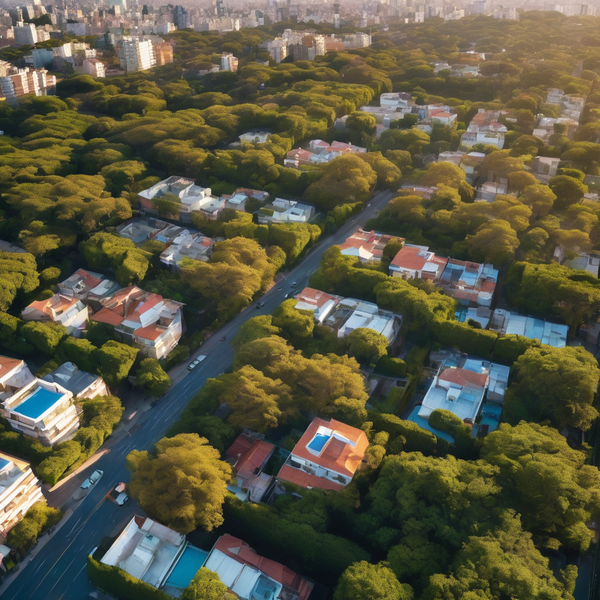With human activities releasing more carbon dioxide (CO2) into the atmosphere than natural processes can remove, new analysis has shed light on the number of extra trees that cities around the world would need to neutralise their carbon footprint.
Picterra, a leading cloud-native geospatial AI platform, has used its technology to visualise tree coverage in over 25 of the world’s most iconic cities, before analysing external data to estimate their CO2 emissions and the number of trees and the amount of space that it estimates would be required to offset the equivalent carbon.
London would have to make room for another 1,330 Hyde Parks filled with trees to neutralise its carbon footprint.
Meanwhile, New York, home to one of the most visited city parks worldwide, came fifth in the rankings, needing the equivalent of 1,304 Central Parks to counteract its emissions.
Omitting an estimated 320,241,244 tonnes of CO2 every year, Tokyo would have to plant over 2 billion (2,001,507,775) trees, which would require a total of 3,091,141 acres of land, accounting for tree planting density guidelines.
On the opposite end of the scale, Rotterdam demanded the fewest trees to neutralise its approximate 7,930,313 tonnes of emissions, with 49,564,459 trees and 76,548 acres required.
Renowned for its skyscrapers and modern architecture, Dubai came in tenth place overall, yet fared the worst for the number of trees required per person to offset its CO2 levels, at an estimated 130.5 trees for each resident.
A full list of findings can be found in the below league table, ranked from the cities in need of the most trees to the fewest.
|
City |
Total City CO2 (tonnes) |
No. of Trees to Neutralise City CO2 |
No. of Acres Required to Neutralise Total CO2 |
No. of Trees Required Per Person (according to 2022 population figures) |
|
Tokyo |
320,241,244 |
2,001,507,775 |
3,091,141.1 |
51.7 |
|
Beijing |
192,630,994 |
1,203,943,712 |
1,859,378.2 |
53.1 |
|
Moscow |
168,775,978 |
1,054,849,860 |
1,629,116.7 |
79.9 |
|
Seoul |
122,453,481 |
765,334,255 |
1,181,987 |
73.6 |
|
New York |
113,904,467 |
711,902,920 |
1,099,467.3 |
86.6 |
|
Toronto |
96,981,201 |
606,132,505 |
936,114.8 |
91.3 |
|
Mexico City |
79,321,934 |
495,762,085 |
765,658.1 |
21.4 |
|
Sydney |
77,427,917 |
483,924,483 |
747,376 |
90.7 |
|
Montreal |
65,567,121 |
409,794,505 |
632,889.2 |
91.3 |
|
Dubai |
65,414,930 |
408,843,314 |
631,420.2 |
130.5 |
|
New Delhi |
62,917,900 |
393,236,876 |
607317.5 |
11.5 |
|
Buenos Aires |
61,496,948 |
384,355,922 |
593,601.7 |
23.8 |
|
Cairo |
55,458,003 |
346,612,516 |
535,310.5 |
15.0 |
|
Los Angeles |
54,431,363 |
340,196,021 |
525,400.9 |
86.6 |
|
Singapore |
53,815,602 |
336,347,513 |
519,457.2 |
53.1 |
|
Paris |
53,352,174 |
333,451,090 |
514,984.0 |
28.6 |
|
London |
48,240,550 |
301,503,438 |
465,643.8 |
30.0 |
|
Chicago |
37,665,657 |
235,410,356 |
363,569.2 |
86.6 |
|
Cape Town |
33,009,390 |
206,308,688 |
318,624.4 |
40.5 |
|
Hong Kong |
32,583,556 |
203,647,227 |
314,514.1 |
25.4 |
|
Barcelona |
31,166,711 |
194,791,943 |
300,837.9 |
32.9 |
|
Rio de Janeiro |
29,514,598 |
184,466,238 |
284,890.8 |
12.9 |
|
Berlin |
29,163,334 |
182,270,838 |
281,500.2 |
49.0 |
|
Milan |
17,287,044 |
108,044,023 |
166,863.9 |
32.9 |
|
Lisbon |
12,212,182 |
76,326,135 |
117,878.6 |
24.4 |
|
Rotterdam |
7,930,313 |
49,564,459 |
76,547.7 |
46.7 |
Using its geospatial AI software, Picterra looked at the current state of forestry in each city, giving a realistic picture of how each city fares.
Picterra enables its users to detect any objects, in this case, trees, faster than ever before by managing the entire geospatial machine learning pipeline with its cloud-native platform.
Commenting on the findings, Frank de Morsier, chief operating officer at Picterra, said:
“We aim to make a positive and meaningful impact on our planet and environment. That’s why we have used our geospatial AI tool to visualise the number of trees there currently are in each city’s centre, giving a realistic view of the state of forestation in the cityscapes we know so well, with stark differences evident.
‘While the analysis of existing data alongside these visualisations is simply an estimate of how many trees and acres are needed to neutralise carbon emissions, it serves to illuminate how deep of an issue current CO2 levels are.
“Planting trees remains one of the most effective ways to temper carbon emissions – though, as this analysis shows, this would need to be on an extreme scale to make progress towards neutrality.”



